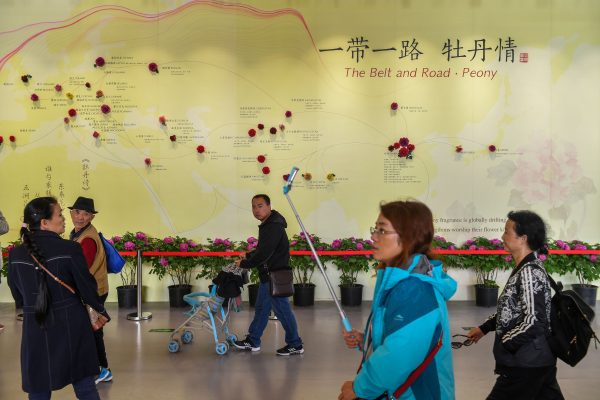China deserves to be taken seriously and have its international personality assessed on available evidence, not framed in advance as something inherently disruptive.
This is our starting point in considering the major component of China’s contemporary conversation with the world, the Belt and Road Initiative (BRI).
It is striking that as China has risen, it has not settled on a message of nationalism, exceptionalism, or of some version of exclusivity. The tone around the BRI is that of engagement — China seeks to make its involvement with the world a conversation about economic growth, connectivity or — to use an expression conceived in 19th century Australian politics — about ‘roads and bridges’.
It attempts to capture the spirit of the Silk Road (or the Tang Dynasty that sponsored it), during which China first opened to the world and the world first opened to China. As Chinese politician Huang Kunming says, ‘History is our best guide’.
There is a debate taking place in Beijing between those who want further reform and openness, and those inclined to retreat into protectionism and economic self-reliance. Chinese history should guide decision makers towards a new burst of openness. Chinese reformers think that this is the better path, given the challenge of economic nationalism and the threat of trade wars being directed at China by US President Donald Trump. The United States may be doing China a favour by pushing it towards further reform.
The BRI certainly delivers for China. It exports its surplus infrastructure capacity as demonstrated by high-speed rail. Once China has connected Kunming — the capital city of its southern Yunnan province — with the rest of the high-speed rail network, there is an obvious appeal in building high-speed rail from Kunming over the border into Laos.
But the BRI also delivers a public good — a greater level of peace and security across Central and South Asia as nations engage in a conversation about connectivity and infrastructure. It confirms that China is not aiming to overturn the post-war order, but rather add to the stock of global institutions that work to maintain it. China’s sponsorship of regional diplomatic structures in the form of the Shanghai Cooperation Organisation and the Asian Infrastructure Investment Bank (AIIB) confirm this notion.
The challenge for China is to present compelling arguments that persuade others to explore and commit to opportunities under the BRI’s umbrella. The proper identification of private sector investment opportunities will be crucial. One milestone will be when private sector investors of OECD countries can study a flow of investment opportunities — a stream of potential deals — they can respond to. In other words, the private sector in the Western world will be looking for ‘a deal flow’ that is more than a string of investment proposals, but also a set of rules to govern private sector investments and make them viable.
More specifically, private sector investors want to see a number of guarantees.
Investors want better safeguards against sovereign risk, such as limiting any rule changing after funds have been committed. They also want better opportunities for private–public partnerships, such as airports, logistic centres, toll roads and social infrastructure like schools and hospitals that are also governed by a common rulebook. Investors are also seeking commitments to sustainability that minimise the risk of any project degenerating into arguments about blame for social disruption or for environmental disasters. Specifically, China will need to build a commitment to the UN Sustainable Development Goals into the BRI.
This approach, which might be described as the multilaterisation of the BRI, will protect the interests of private investors from OECD economies. But it might also be seen as protecting the interests of Chinese taxpayers. Like taxpayers anywhere, they will react angrily if their money is squandered because of poor governance in host countries — this is polite language for corruption — or investments are made for local political purposes without a convincing business case.
The AIIB provides something of a model for such a multilateral BRI. What might have been a Beijing-based, Chinese-operated bank making loans for infrastructure in Asia was, instead, devised as a multilateral organisation with rules crafted by China’s partners who were more ready to participate in the bank because of its multilateral character.
Chinese President Xi Jinping’s views seem to nod in this direction. But what foreign investors will want to see fairly quickly is a list of concrete projects that are economically, environmentally and socially viable. In this context the BRI can emerge as Chinese-sponsored, but transparent, and multilateral — and a decisive contribution to public global good.
The Hon. Bob Carr is a former Premier of New South Wales (1995–2005), a former Australian Minister for Foreign Affairs (2012–2013) and the former Director of the Australia–China Relations Institute, the University of Technology Sydney (2014–2019).


I think the proposal by the author on the multilaterisation of the BRI is an excellent idea.
As the author has argued that if the BRI can encourage and get more or increase the private sector investors in the OECD countries to participate in the BRI project, it will create a lot of opportunities for PPPs on a world wide scale. It will have the potential to chanel and mobilise many OECD private investors to the much needed infrastructure development in many countries. If that is realised, it will contribute greatly to the development of the whole world.
As the author argued, the multilaterisation of the BRI, will protect both the interests of private investors from OECD economies and the interests of Chinese taxpayers.
I personally don’t know how the BRI is governed, but it would certainly be beneficial to all participating parties including China and Chinese taxpayers, if BRI governance includes participating parties or their representatives in a practical way and international organisations which have goodwills without undue influences by any spoilers.